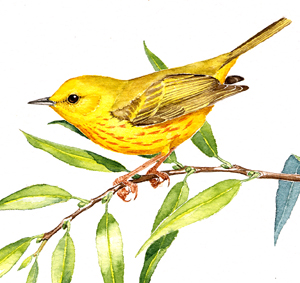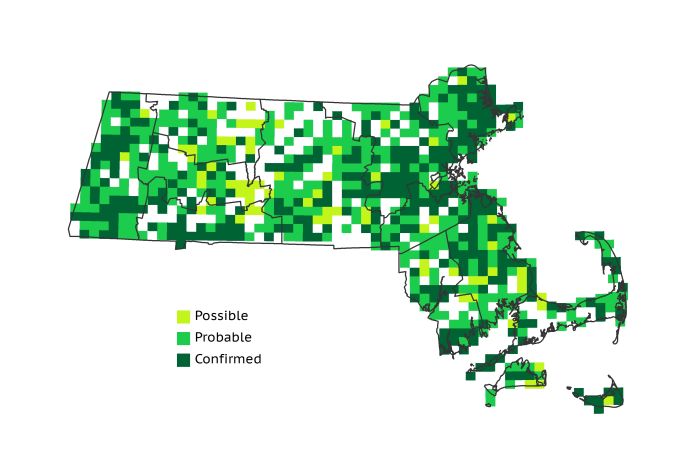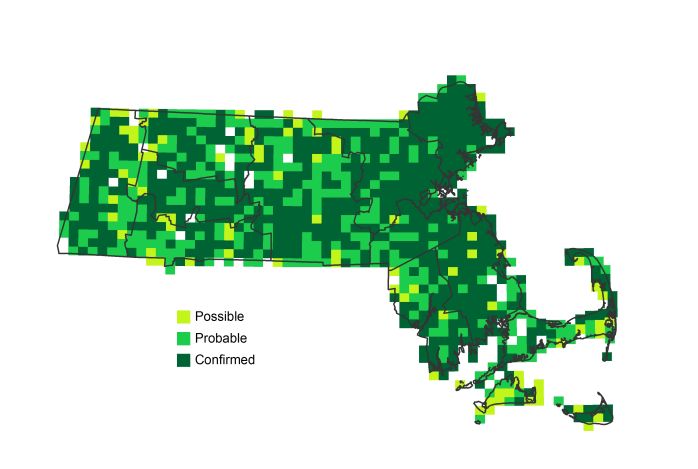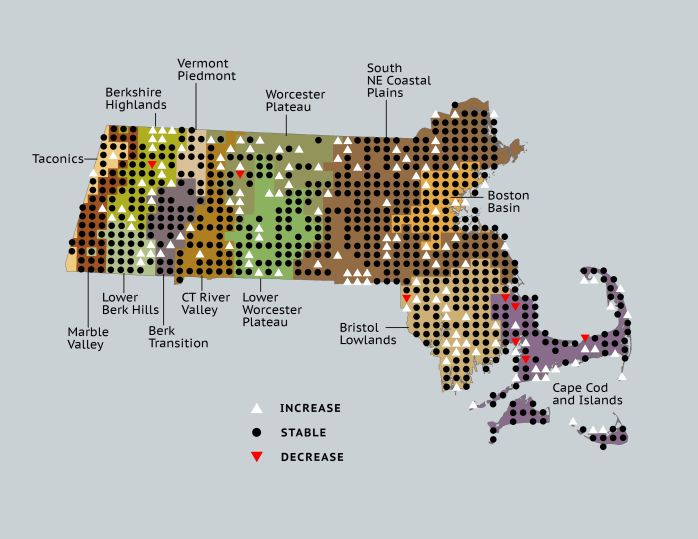Find a Bird
Yellow Warbler
Dendroica petechia

Nearly ubiquitous and likely increasing
“The Yellow Warbler is a bit of feathered sunshine. In his plumes dwells the gold of the sun, in his voice its brightness and good cheer.“ —Frank Michler Chapman, The Warblers of North America
The Yellow Warbler is one of the most widespread and familiar of American warblers. It is represented by a sizable number of subspecies from Alaska to Peru and eastward across North America to the Atlantic Ocean. Yellow Warblers are best known as birds of riparian habitats, where they favor willow trees and alders for feeding and nesting, but they will also inhabit a wide variety of forest types where the opportunity presents itself. In Massachusetts, Yellow Warblers are more widespread today than perhaps ever before.
Historic Status
Historical accounts of Yellow Warblers, or Summer Yellow Birds, reveal nothing negative about the species’ past population levels or breeding distribution. Howe and Allen described the Yellow Warbler as “An abundant summer resident,” at the dawn of the twentieth century (Howe & Allen 1901). The species proliferated when forests were cleared, though it probably suffered some with the plowing under of wetlands in the middle of the twentieth century. By the time birders took to the field for Atlas 1, the Yellow Warbler was a longtime favorite species with many Massachusetts residents.
Atlas 1 Distribution
While it was widespread during Atlas 1, being found in 75% of the blocks surveyed, the Yellow Warbler is often associated with the edges of wetland habitat. This likely drove some of its distribution patterns, although it is the common warbler of shrubby fields as well. The areas of the state in which they were scarcer during Atlas 1 tended to be regions of high elevation and/or dense forest, where there was less of the moist edge habitat that the species seems to prefer. Accordingly, the greatest distribution gap was in the western part of the state in the Berkshire Highlands region. The other region that had notably fewer Yellow Warbler blocks than surrounding regions was the Worcester Plateau, in many ways a zone similar to the Berkshire Highlands. Yellow Warblers were widespread through the rest of the state, excepting the heart of Boston and the driest areas of Cape Cod and the Islands.
Atlas 2 Distribution and Change
Frequenting the edges of rivers and forgotten ponds near the margins of suburban development, Yellow Warblers held on tenaciously through the inter-Atlas period and even showed signs of expansion, leaping to 93% block occupancy statewide. This persistence was particularly noticeable in the western part of the state, where the Yellow Warbler disappeared from only a single block while colonizing more than two dozen new ones. The Worcester Plateau saw the largest gain in total blocks of any ecoregion west of the Coastal Plains, indicating that this species is perfectly capable of breeding in the higher regions of the Commonwealth. What gaps existed in the eastern and southeastern distributions of the Yellow Warbler were consolidated between the Atlases, presenting an almost unbroken sea of green on the distribution maps. The Cape and Islands maintained several “holdout” blocks where no Yellow Warblers could be found, or were only listed as Possible breeders.
Atlas 1 Map

Atlas 2 Map

Atlas Change Map

Ecoregion Data
Atlas 1 | Atlas 2 | Change | ||||||
Ecoregion | # Blocks | % Blocks | % of Range | # Blocks | % Blocks | % of Range | Change in # Blocks | Change in % Blocks |
Taconic Mountains | 12 | 75.0 | 1.7 | 18 | 72.0 | 1.9 | 2 | 13.3 |
Marble Valleys/Housatonic Valley | 38 | 97.4 | 5.2 | 39 | 100.0 | 4.0 | 1 | 2.6 |
Berkshire Highlands | 35 | 63.6 | 4.8 | 51 | 92.7 | 5.3 | 0 | 0.0 |
Lower Berkshire Hills | 23 | 82.1 | 3.2 | 28 | 90.3 | 2.9 | 3 | 11.1 |
Vermont Piedmont | 15 | 88.2 | 2.1 | 17 | 100.0 | 1.8 | 0 | 0.0 |
Berkshire Transition | 30 | 78.9 | 4.1 | 39 | 97.5 | 4.0 | 6 | 19.4 |
Connecticut River Valley | 46 | 82.1 | 6.3 | 61 | 93.8 | 6.3 | 6 | 12.5 |
Worcester Plateau | 36 | 46.2 | 5.0 | 79 | 89.8 | 8.2 | 16 | 33.3 |
Lower Worcester Plateau | 56 | 75.7 | 7.7 | 76 | 95.0 | 7.9 | 7 | 13.0 |
S. New England Coastal Plains and Hills | 214 | 79.3 | 29.5 | 277 | 97.9 | 28.7 | 36 | 15.9 |
Boston Basin | 46 | 82.1 | 6.3 | 53 | 94.6 | 5.5 | 5 | 9.1 |
Bristol and Narragansett Lowlands | 85 | 80.2 | 11.7 | 109 | 95.6 | 11.3 | 18 | 17.8 |
Cape Cod and Islands | 89 | 65.4 | 12.3 | 117 | 81.3 | 12.1 | 18 | 15.0 |
Statewide Total | 725 | 74.8 | 100.0 | 964 | 93.0 | 100.0 | 118 | 14.2 |
Notes
The Yellow Warbler shows a significant decreasing Breeding Bird Survey trend in the Eastern US overall.



